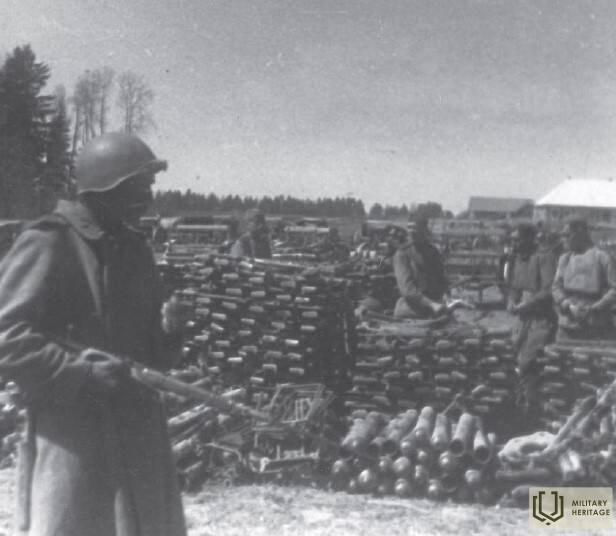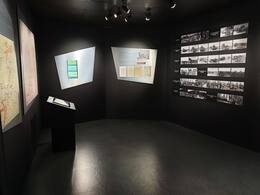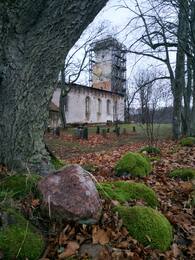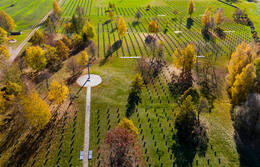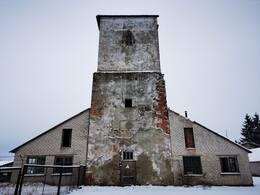Memories of Jānis Miesnieks, a native of Ezera, about the end of World War II in Ezera
The Ezere Cultural History and Local History Museum "Customs House" is located in a historically significant building. On May 8, 1945, the act of capitulation of the Nazi German army units encircled on the Kurzeme Front was signed here.
Former Ezer resident Jānis Miesnieks (born 1930) shares his memories of the events of that day.
The spring of 1945 came and the front line was already near Saldus. All the neighbors also returned from the forced evacuation to Lithuania. By a stroke of fate, I became a witness to an important historical event. One May day, a young man from Mažeikiai had come to receive payment for the work he had done during the summer. We loaded the respective sacks of grain into a horse-drawn cart, which was pulled by the old, very experienced mare Irma. Movement could only take place along the very narrow side of the highway, because in the middle there was a deep, muddy furrow driven by heavy machinery. It was already afternoon when we left “Zaķi” for Ezeri. The speed at which we were moving forward could have been about 3 km per hour. However, an army road patrol did not let us cross the Vadakste bridge in Ezeri to Mažeikiai. The next bridge over the Vadakste was at Laižuva and instead of 13 km, the road to the destination became 33 km long. After a few kilometers, like phantoms from another dimension, several excellent black limousines slowly moved towards us along this dilapidated road. We could clearly see the people sitting in the cabin - high-ranking Red Army commanders, but at the very back, a German officer with characteristic tall uniform hats was sitting. On the way, we also heard quite loud noises from the front. But when night fell on the road, the entire front line was ablaze with fire, a rocket salute, the trails of shining bullets decorated the edge of the sky like strings of beads. Beautiful, if only without the price of blood. It was obvious that the hellish hell in my Kurzeme region had begun to boil uncontrollably... The darker it got, the more intensely the front lights illuminated the edge.
We reached Mažeikiai at sunrise. A modest cottage on the outskirts, it turns out, was the final destination of our long journey, made with considerable effort and filled with exciting events. Here the cargo was unloaded, and we received what seemed like an incomprehensible message: the war is over!!! Yesterday, on May 8, the Germans had signed a capitulation in Ezere.
With the emptied cart, I immediately set off straight home through the Lake, dozing off from exhaustion. In less than a day, the situation in the world had changed dramatically: when I left home yesterday, there was still a state of war, but on the morning of May 9, peace reigned. In the Lake, behind the Vadakste Bridge, I passed the former customs house, where yesterday the authorized representatives of the Wehrmacht had signed the act of unconditional surrender of the armies of the Kurzeme encirclement front. It was for this reason that the road across the bridge was closed yesterday and fate gave me the opportunity to see the participants involved in the event and the surge of emotions at the front on the first night of peace. With this, the hellish stew in the Kurzeme cauldron had stopped boiling. When I returned to “Zaķi” on the morning of May 9, the army liaison officers living in our house were in a real panic…
Related timeline
Related objects
Ezere local history repository “Muitas Nams” (Customs House)
The Ezere Customs House is located in Ezere near the Saldus-Mažeikiai highway at the Latvian-Lithuanian border. The act of surrender of the German Army units ‘Kurzeme’ (Kurland) surrounded in the so-called ‘Courland Pocket’ was signed in this building on 8 May 1945. It is believed that World War II actually ended in Ezere. The customs house has an exhibit covering the events of the end of World War II and exhibits detailing the history of Ezere parish from ancient to modern days. In the morning of 7 May 1945, the commander of the Leningrad Front, Marshal L. Govorov, sent an ultimatum to the command of the army group ‘Kurzeme’ to lay down arms. The act of surrender was signed by the involved parties on May 8 and it detailed the procedure of surrender, weapons collection points, documents and information to be submitted and other practical measures.
Red Army prisoner filtration camp in Grieze and Grieze Church
Grieze is located at the Latvian-Lithuanian border, where the Vadakste River flows into the Venta River. The Grieze church was built in 1580, but the parish existed before 1567. The church was rebuilt several times - in 1769, in 1845 and in 1773 the first organ was installed. Both the altarpiece and the two bells have been lost for various reasons.
In the church garden there is a cemetery where people belonging to the church and noblemen are buried. One of them is Grieze organist Friedrich Baris and his wife Charlotte, who have a monument erected in front of the church sacristy. On the south side of the church, 32 Swedish soldiers who died in the Great Northern War are buried. The cemetery also contains the graves of 110 German soldiers who died in the First World War, for whom a monument was erected in 1930.
During the Second World War, the church suffered when the front line was stretched along the Venta River in late October 1944 and the German 225th Infantry Division was stationed in the vicinity of Grieze Church. When the Soviet 4th Shock Army launched attacks across the Venta River on 19 November 1944, several artillery shells hit the south wall of the church and the church tower was badly damaged.
After the surrender of Army Group Kurzeme, the Red Army's Leningrad Front accounted for 284 171 people taken prisoner. 7493 were Red Army soldiers released from German captivity. 48 German generals surrendered to captivity. According to the documents submitted at the time of the surrender of Army Group Kurzeme, the number of soldiers was about 185 000. The rest of the nearly 100 000 people subjected to filtration were Kurzeme civilians and Soviet refugees, as the Soviet Leningrad Front ordered on 10 May 1945 that all men between the ages of 16 and 60 be subjected to filtration.
In the Red Army, unlike the armed forces of other countries, the screening, guarding, maintenance and protection of prisoners of war was carried out not by army units, but by the internal affairs bodies - the People's Commissariat for State Security. The main task of the filtration was to detect citizens of the USSR and Soviet-occupied countries who had taken part in the hostilities on the German side. Captured German soldiers were examined in order to detect possible perpetrators of war crimes.
A prisoner-of-war filtration camp was located in the vicinity of the Grieze Church from 10 May to 17 June 1945. The camp was probably located here because the Grieze Church was close to the main roads. The pits in the ground where the prisoners hid from the cold on cold nights by covering themselves with whatever was available are still clearly visible in the surrounding area. During this period, the Red Army caused considerable damage to the interior of the church (all the pews were removed - "for the war effort", the pulpit was damaged, the organ was destroyed, etc.). A laundry was set up in the church building itself.
The last service in the church was in 1950 and the congregation ceased to exist. After the dissolution of the congregation, also later under the supervision of the Latvian Society for the Protection of Nature and Monuments, the church was not repaired. However, the building stood under roof until the 1960s-1970s. The church was damaged during the storm of 1961 and in 1968 the remaining interior elements were rescued by the Rundāle Palace staff.
Since 2003, a group of like-minded people from Riga parishes have been involved in the clean-up and restoration of the church. To date, the church walls have been conserved and the tower has been restored.
Saldus German Soldiers' Cemetery
The Saldus German Soldiers' Cemetery is located on the Saldus–Ezeres highway. The cemetery, which covers an area of 8 hectares, contains the remains of around 25,000 German soldiers, as well as some Latvian legionnaires. Reburials have been taking place since 1997.
From May 1 to October 1, an exhibition about the battles of Courland can be viewed in the memorial room. During this period, the memorial room is open on weekdays from 9:00 to 17:00, and on Saturdays and Sundays a guide is also working in the cemetery. Registers of soldiers buried in the Saldus German soldiers' cemetery and soldiers who fell throughout Latvia are also available.
Pampali Church and the walls of the shot-up house
Pampāļi is a settlement in Pampāļi parish, Saldus municipality, the center of the parish on the banks of the Zaņa River and its tributary Abrupe, 27 km from the county center Saldus and 147 km from Riga. The settlement developed around the center of the Pampāļi manor after the agrarian reform. In 1933, Pampāļi was granted the status of a densely populated area.
The hostilities at the gates of Pampāli began on November 21, 1944, when the Soviet 4th Shock Army, forcing the Venta River, launched an attack in the direction of Saldus. By November 24, the situation stabilized and the front line remained unchanged until December 21.
On December 21, 1944, the so-called 3rd Battle of Courland began, during which the 4th Shock Army of the 1st Baltic Front with 4 rifle corps (12 rifle divisions) and the 3rd Guards Mechanized Corps attacked in the direction of Saldus to link up with units of the 2nd Baltic Front. The German 132nd Infantry Division defended the Pampāli area, whose 1st Battalion of the 436th Grenadier Regiment was fortified in the area of the manor and church.
The attack on Pampāli was carried out by the 357th and 145th Rifle Divisions of the 1st Rifle Corps, supported by massive artillery fire, and the 39th Guards Tank Brigade. Within the first 24 hours of the battle, the Pampāli garrison, commanded by Captain Eberard Coll, commander of the 14th (anti-tank) company of the 436th Grenadier Regiment, was surrounded and practically destroyed in fierce fighting.
Since Pampāļi was located right on the front line, all the buildings suffered from artillery fire and have practically not survived today.




